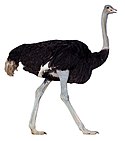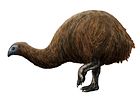Pachystruthio
| Pachystruthio Temporal range:
| |
|---|---|

| |
| Restoration of a male P. dmanisensis. | |
| Scientific classification | |
| Domain: | Eukaryota |
| Kingdom: | Animalia |
| Phylum: | Chordata |
| Class: | Aves |
| Infraclass: | Palaeognathae |
| Order: | Struthioniformes |
| Family: | Struthionidae |
| Genus: | †Pachystruthio (Kretzoi, 1954) |
| Type species | |
| Pachystruthio pannonicus (Kretzoi, 1954)
| |
| Species | |
| |
| Synonyms | |
| |
Pachystruthio is a genus of extinct bird which lived in Eurasia from the Late Pliocene to the Middle Pleistocene.[1] Its fossils have been found in Hungary, Greece[2] Crimea, Georgia, and China.[3] The genus contains three species: P. pannonicus (the type species), P. dmanisensis, and P. transcaucasicus, which were all formerly placed with the ostrich genus, Struthio. An incomplete femur from the Nihewan Formation (China) has been assigned to Pachystruthio indet. P. dmanisensis has been estimated standing 3.5 meters (11.5 feet) tall and weighing up to 450 kg (990 lb), making it much larger than the modern ostrich and one of the largest known birds.[1]
Although P. dmanisensis is known as the giant ostrich, its relationship to the extant ostriches of the genus Struthio is not clear.[1][4]
Some authors have suggested placing the large (albeit smaller than P. dmanisensis) extinct ostrich species Struthio anderssoni from the Late Pleistocene of China in the genus.[5]
See also
[edit]- Struthio wimani, flightless bird fossils in China
- Struthio orlovi, flightless bird fossils in Central and Eastern Europe
References
[edit]- ^ a b c Zelenkov, N. V.; Lavrov, A. V.; Startsev, D. B.; Vislobokova, I. A.; Lopatin, A. V. (2019). "A giant early Pleistocene bird from eastern Europe: unexpected component of terrestrial faunas at the time of early Homo arrival". Journal of Vertebrate Paleontology. 39 (2): e1605521. Bibcode:2019JVPal..39E5521Z. doi:10.1080/02724634.2019.1605521. S2CID 198384367.
- ^ Kostopoulos, Dimitris S.; Konidaris, George E.; Amanatidou, Marina; Chitoglou, Krystalia; Fragkioudakis, Emmanouil; Gerakakis, Nikolaos; Giannakou, Vasiliki; Gkeme, Anastasia; Kalaitzi, Christina; Tsakalidis, Christos; Tsatsalis, Vaggelis (March 2023). "The new fossil site Krimni-3 in Mygdonia Basin and the first evidence of a giant ostrich in the Early Pleistocene of Greece". PalZ. 97 (1): 147–161. Bibcode:2023PalZ...97..147K. doi:10.1007/s12542-022-00632-8. ISSN 0031-0220. S2CID 252750662.
- ^ Buffetaut, Eric; Angst, Delphine (2021). "A Giant Ostrich from the Lower Pleistocene Nihewan Formation of North China, with a Review of the Fossil Ostriches of China". Diversity. 13 (2): 47. doi:10.3390/d13020047. hdl:1983/0d3c1bba-d496-47b6-a61c-e141a472612a.
- ^ McRae, Mike (27 June 2019). "Giant 11-Foot Bird Discovered in Europe Would Have Weighed Almost Half a Tonne". ScienceAlert. Retrieved 2019-06-27.
- ^ Buffetaut, Eric (2023-02-13). "The Missing Late Pleistocene Ostrich Femur from Zhoukoudian (China): New Information Provided by a Rediscovered Old Cast". Diversity. 15 (2): 265. doi:10.3390/d15020265. ISSN 1424-2818.
- Burchak-Abramovich, N.; Vekua, A. (1990). "The fossil ostrich Struthio dmanisensis sp. n., from the Lower Pleistocene of Georgia" (PDF). Acta Zoologica Cracoviensia. 33 (7): 121–132.
- Hitchcock, Don (2010). "The Dmanisi Site". Retrieved 16 February 2011.
- Zicha, Ondrej (1999). "Struthio orlovi". Biological Library. Retrieved 2 February 2010.



